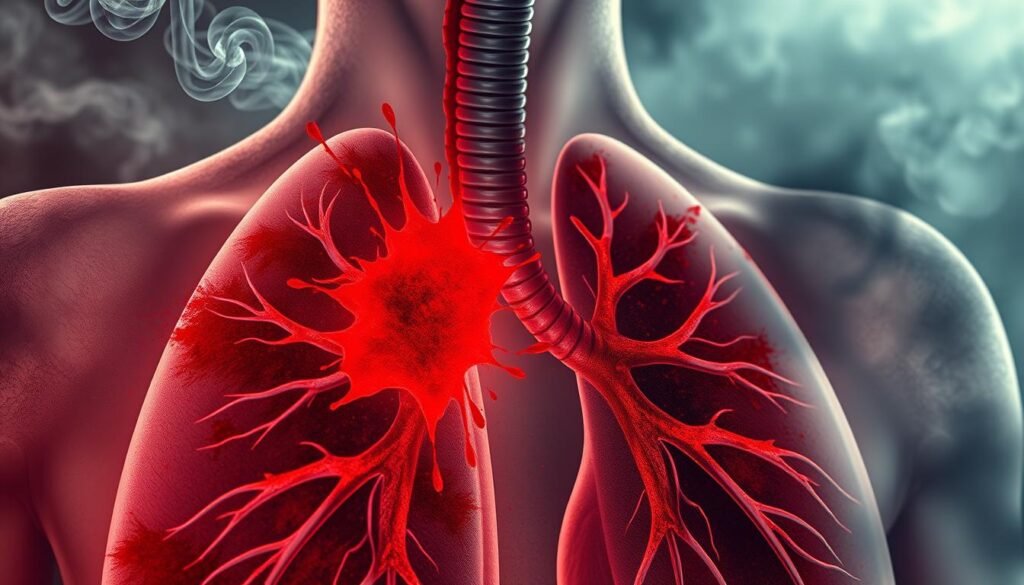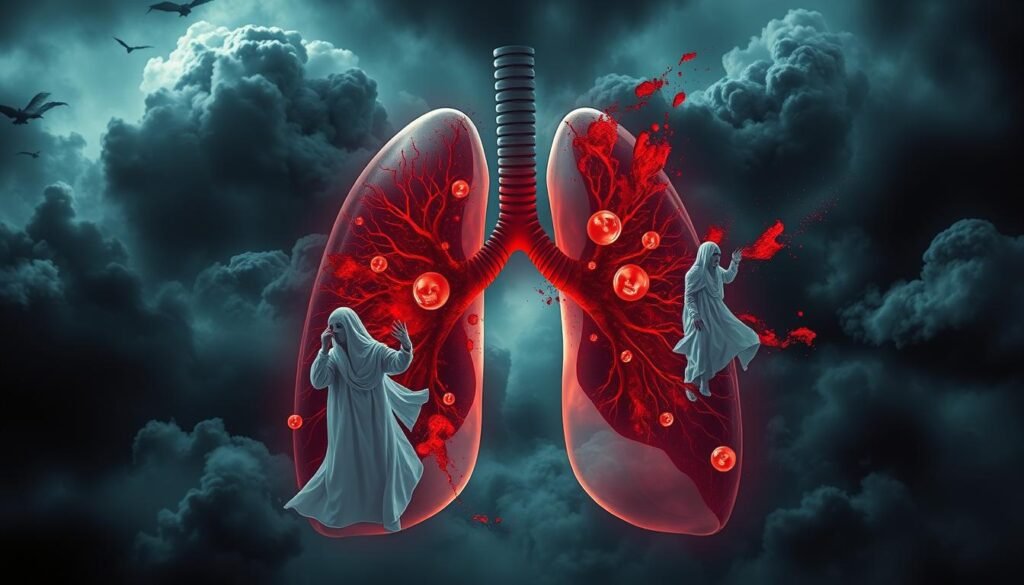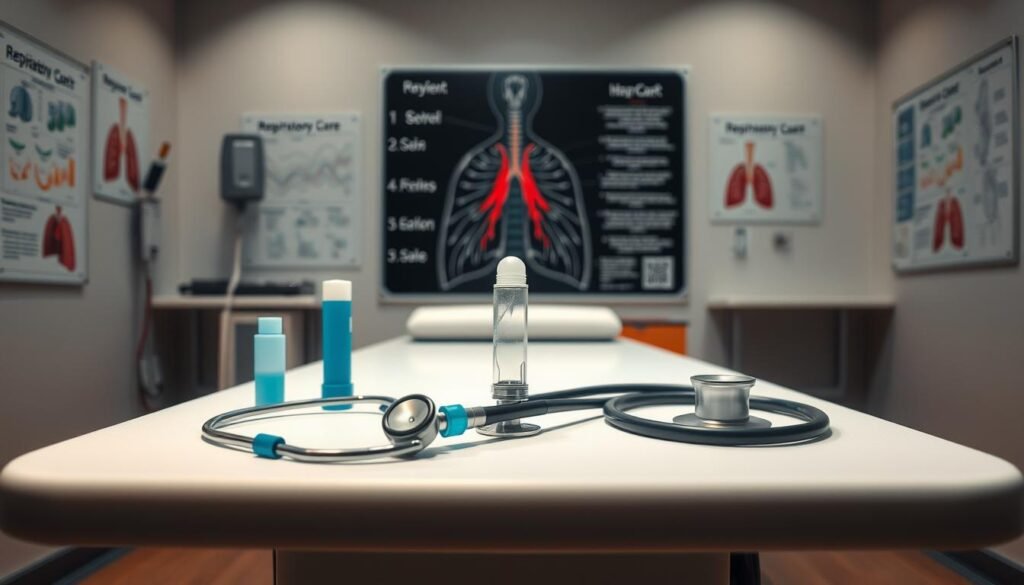About 90% of people who cough up blood can find the reason with careful checks. Coughing up blood, or hemoptysis, is a serious sign. It can point to major health problems. It often comes with other issues like hard breathing and ongoing coughs. These signs are important and need quick action and understanding.
Having trouble breathing can be light, like being a bit out of breath, or very bad. Coughing is normal and helps keep airways clear. But if coughing doesn’t stop or is very bad, it could mean something serious. Hemoptysis makes things worse by showing it might be lung cancer, pneumonia, or TB.
It’s key to get what these breathing problems mean for the right help. Knowing about them helps a lot in getting better. Early help from a doctor makes a big difference for those with these symptoms.
Key Takeaways
- Hemoptysis can indicate serious issues and should not be taken lightly.
- Breathing difficulties can manifest in various forms, impacting overall health.
- Coughing can serve as a vital signal for underlying respiratory conditions.
- Identifying the cause of hemoptysis is crucial for effective treatment.
- Regular check-ups and consultation with a healthcare provider are essential for lung health.
Understanding Breathing Difficulties
Breathing problems can come from many conditions that hurt how well we breathe. These issues are often found in people with chronic obstructive pulmonary disease (COPD), asthma, pneumonia, and pulmonary fibrosis. They can make daily life hard because of symptoms like shortness of breath, wheezing, and feeling tired.
It’s really important to see a doctor if you’re having trouble breathing all the time. This could mean there’s a big health problem that needs quick help. Things around us, like how clean the air is and whether someone smokes, also affect how bad these symptoms can get.
Knowing what causes these breathing problems can help us handle them better. It’s very important to learn more, especially about coughing up blood. This can point to different health issues, so being aware and taking action early is key.
| Condition | Effect on Respiratory Function |
|---|---|
| Chronic Obstructive Pulmonary Disease (COPD) | Limits airflow leading to breathing difficulties. |
| Asthma | Causes airway inflammation, constricting airflow. |
| Pneumonia | Infection that fills the lungs with fluid, impairing function. |
| Pulmonary Fibrosis | Scarring of lung tissue reduces elasticity and function. |
Common Causes of Coughing
Coughing helps clear our airways and can signal health issues. Knowing about Cough Causes is key for good Lung Health. Things like acute and chronic bronchitis, pneumonia, and lung cancer can make us cough. They show different Respiratory Symptoms of concern.
Infections are often to blame. They can be viral or bacterial, making more mucus and causing irritation. Thus, we cough. A 2015 study found that 64% of cases with serious coughing and blood came from infections. Tuberculosis is a top reason worldwide for coughing up blood, especially in those with weak immune systems.
In hospitals, conditions like bronchiectasis, lung cancer, and severe bronchitis or pneumonia are common reasons for coughing up blood among patients. Diagnostic tests help doctors find the cause of hemoptysis. In severe cases, it may lead to emergencies, especially with chest pain and short breath.
Also, medical procedures can make people cough up blood. Tools like bronchoscopies and lung biopsies can cause bleeding in small blood vessels. Any blood in a cough is serious and needs checking to decide on the next steps.
Hemoptysis: What It Is
Hemoptysis is when you cough up blood or blood-stained spit from your lungs or airways. This serious respiratory symptom shows there may be underlying health issues. It’s key to know what it means and its types.
Definition of Hemoptysis
Understanding hemoptysis is important for spotting health dangers. It might be a little blood or a lot. The amount of blood coughed up classifies it:
- Massive hemoptysis: This means coughing up over 100 mL of blood, indicating an urgent health problem.
- Non-life-threatening hemoptysis: Called moderate or submassive, here blood amounts range from 20 to 200 mL.
- Scant or mild hemoptysis: This is when less than 20 mL is coughed up. It shows why measuring blood is important for doctors.
Types of Hemoptysis
Knowing the types of hemoptysis helps spot possible health issues. Common causes include:
- Respiratory infections like bronchitis, pneumonia, and tuberculosis.
- Chronic Obstructive Pulmonary Disease (COPD), harming blood vessels.
- Lung cancer. It might be an early sign if blood is coughed up.
- Pulmonary Embolism, leading to blood clot-induced coughing of blood.
- Bronchiectasis, which causes wide airways and more coughing up blood.
Other symptoms often come with hemoptysis, such as trouble breathing, chest pain, wheezing, and fever. These are especially linked to infections. Chest X-rays and CT scans are key to find what’s causing hemoptysis.
If you’re coughing up blood, see a doctor right away. Knowing the symptoms and what they might mean is crucial for good health. For more details, especially on lung cancer signs, check out early signs of lung cancer.
Breathing Difficulties, Coughing, and Hemoptysis (Coughing Up Blood)
It’s critical to understand how breathing problems, coughing, and hemoptysis are connected. Hemoptysis, or coughing up blood, can be scary. It might come from different problems, like infections. Pneumonia and bronchitis often cause it, especially in older people or those with lung diseases.
There are levels to how severe hemoptysis can be. Mild cases see less than 100 mL of blood coughed up in a day. Moderate ones have 50 to 200 mL, while massive hemoptysis goes over 200 mL. Losing this much blood quickly is dangerous and needs fast medical help.
Several health issues can make someone cough up blood. These include:
- Lung cancer, especially in those over 40 or smokers, often shows up with hemoptysis.
- Cystic fibrosis, a genetic disorder, harms the lungs and can lead to coughing blood.
- Chronic obstructive pulmonary disease (COPD) also causes bleeding by blocking airflow.
- Pulmonary embolism can cause coughing blood, breathing problems, and chest pain.
We must tell apart hemoptysis from hematemesis, which is vomiting blood due to stomach issues. Getting the right diagnosis is key. Tests like CT scans, bronchoscopy, and biopsies help find the cause of the problems.

To wrap up, dealing with hemoptysis means keeping a close watch on our health. Anyone coughing up a lot of blood with other symptoms should get checked out right away. This helps figure out what’s wrong and how to treat it properly.
Identifying Respiratory Symptoms
It’s important to recognize respiratory symptoms to understand health issues better. Shortness of breath and chest pain are key signs. They often point to serious conditions.
Shortness of Breath
Shortness of breath may come from heart or lung problems. It could happen while you’re active or even at rest. Anxiety can also cause it. If breathlessness is severe or lasts a long time, seeing a doctor is crucial. It might mean something serious.
Keeping track of symptoms like chest pain or feeling dizzy helps. These details aid doctors in their assessment.
Chest Pain and Discomfort
Pleuristic pain in the chest is common in respiratory sicknesses. It happens in conditions like pneumonia or lung blood clots. Knowing when chest pain occurs with breathing is helpful for pinpointing issues.
Chest pain with difficulty breathing needs urgent care. Telling doctors about these symptoms improves diagnosis and treatment. For more on serious symptoms like coughing up blood, visit this resource.
Potential Pulmonary Disorders
A variety of lung disorders can really affect a person’s lung health. This can lead to hard breathing and a cough that won’t go away. Diseases such as chronic obstructive pulmonary disease (COPD), lung cancer, and tuberculosis are big worries. Knowing about these diseases early on helps in dealing with them better.
Infections like pneumonia and bronchiectasis also cause breathing problems. Research shows that these infections cause about 25.8% of hemoptysis cases. Meanwhile, lung cancer is behind around 17.4% of them. Also, bronchiectasis is a factor in 6.8% of cases. This info helps us understand lung diseases better.
Getting medical help early is crucial for anyone showing symptoms. Early detection is key to improving lung health and avoiding worse problems. The treatment depends on the disease and how severe it is. So, knowing about your condition helps in getting the right treatment, leading to better health.

The Link Between Lung Health and Hemoptysis
Lung health is key to our overall well-being. Hemoptysis shows us there might be respiratory problems. When someone coughs up blood, it’s a sign to pay attention.
Those with weakened lungs face higher risks of serious conditions, such as lung cancer and ongoing infections. Knowing about this link is crucial for taking care of our lungs early on.
Importance of Regular Lung Check-ups
It’s vital to have lung check-ups regularly to catch diseases early. Healthcare professionals urge routine exams. This is especially true for people with risk factors like smoking or a family history of lung issues.
About 20 percent of those with lung cancer will cough up blood. Early check-ups can find issues before they worsen. This allows for quick action to be taken.
If you have a persistent cough or cough up blood, see a doctor right away. Screenings for lung health can find problems early. This helps in dealing with conditions that may cause hemoptysis.
Recent research into treatments such as immunotherapy is improving care for lung cancer. For the latest on lung cancer treatments, check out this immunotherapy guide.
Keeping your lungs healthy with regular check-ups helps prevent serious issues like hemoptysis. Knowing your risk factors and not delaying doctor visits can lead to better health outcomes. With new treatments, the outlook for lung cancer patients is getting better. So, it’s critical to look after our lung health.
When to Seek Medical Attention
Knowing when to get help for breathing problems is key to good health. Watching symptoms helps figure out how urgent the issue is. Some symptoms mean you need care right away, while tests can pinpoint the problem.
Urgent Symptoms to Monitor
Some symptoms mean you should not wait to get help. These include:
- Persistent or worsening hemoptysis
- Severe chest pain
- Shortness of breath, especially with little activity
- A fever over 101 degrees Fahrenheit
These signs may point to serious issues like bronchitis, pneumonia, or lung cancer. Coughing up a lot of bright red or rust-colored mucus is very worrying.
Recommended Diagnostic Tests
Doctors have various tests to find the cause of breathing troubles. Common tests include:
| Test | Purpose |
|---|---|
| Chest X-ray | Shows the lungs and checks for problems |
| CT Scan | Gives detailed lung images for diagnosis |
| Bronchoscopy | Lets doctors see inside airways and take samples |
| Complete Blood Count (CBC) | Checks health and looks for infections |
| Coagulation Tests | Tests blood clotting, important for diagnosing embolisms |
Quick action and the right diagnosis improve treatment and health. It’s important to take serious symptoms seriously and get the right tests.

Treatment Options for Breathing Difficulties
The way we treat breathing problems depends on what’s causing them and how serious they are. For asthma, medications called bronchodilators can really help. They open up the airways, making it easier to breathe. If a bacterial infection is the problem, antibiotics are the go-to treatment to fight off the infection.
Dealing with chronic lung diseases calls for a more complete plan. Pulmonary rehabilitation is an option here. It uses exercise, learning, and support to better lung function and life quality. For bleeding in the lungs, the key is to treat the root cause. Treatments can range from antibiotics for pneumonia to chemotherapy for lung cancer.
Knowing your treatment options is key when you have a lung disorder. The common methods include:
- Medications for inflammation and infection
- Thoracentesis for fluid removal
- Surgery for structural issues or tumors
- Management plans tailored to individual patient needs
It’s important for patients to talk to their doctors to find out the best treatment for them. Regular check-ups and updates to the treatment plan are crucial. This is especially true for people with severe lung issues.
| Treatment Type | Indications | Notes |
|---|---|---|
| Bronchodilators | Asthma, COPD | Relieve airway constriction |
| Antibiotics | Bacterial infections | Target specific pathogens |
| Pulmonary Rehabilitation | Chronic lung diseases | Improves lung function and quality of life |
| Surgery | Severe structural issues | May include tumor resection |
| Diagnostic Tests | Identifying causes | Chest X-ray, CT scan, bronchoscopy |
Choosing the right approach helps manage breathing difficulties well. It also meets the unique needs of the patient. Quick and correct medical action can make a big difference for those with serious lung problems.
Managing Coughing and Hemoptysis
Managing coughs and bleeding from the lungs needs a well-thought-out plan. This plan should cover all parts of Respiratory Care. Figuring out the main causes and using specific Cough Management methods are key. These steps help ease symptoms and better a person’s health. Making healthy changes, like stopping smoking and keeping a clean environment, can boost lung health a lot.
Handling coughs often means using medicine that doctors recommend. These can be cough stoppers, mucus thinners, or antibiotics for infections causing constant coughing. Studies show infections cause most coughing-up-blood cases in the U.S. Diseases like bronchitis and pneumonia are big contributors, with bronchitis causing many of these cases.
For taking care of bleeding from the lungs, knowing the exact cause is very important. Especially with lung cancers being a common cause, quick action is needed. In bad cases, surgery might be the only option. This shows why getting checked by a doctor on time is crucial. Tests like CT scans and looking inside the lungs help find where the bleeding is coming from.
Some people have bleeding from the lungs for unknown reasons. This happens in a significant number of cases. It points out the need for detailed check-ups and close watch by doctors. Working together, healthcare workers can create care plans that meet the needs of each patient.
| Condition | Percentage of Cases |
|---|---|
| Infection (overall) | 60-70% |
| Bronchitis | 26% |
| Pneumonia | 10% |
| Tuberculosis | 8% |
| Primary Lung Cancers | 23% |
| Idiopathic Hemoptysis | 7-34% |
| Foreign Body Aspiration (Children) | Second Most Common Cause |
Handling Coughs and lung bleeding well is a key part of good Respiratory Care. Learning about symptoms and getting help fast can make life better for those facing these tough issues.
Conclusion
Dealing with breathing problems, coughs, and hemoptysis is vital for good respiratory health. Knowing about these signs helps people get help early and take steps to avoid issues. It also means understanding how these symptoms relate can lead to quicker action, preventing worse problems.
Seeing your doctor regularly is key for lung health. Also, life changes like stopping smoking and eating well help avoid big health issues. Since about 0.1% of people see their doctor for hemoptysis each year, staying alert is crucial for better health results.
Given the high death rates from not treating severe hemoptysis, spotting severe signs early is key. Being informed and aware can help maintain good lung health. This leads to a stronger, healthier life overall.